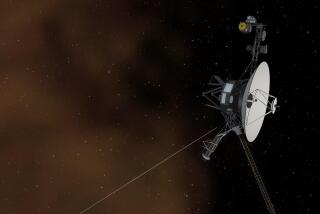Scientists debate whether Voyager 1 has left the solar system
Ladies and gentlemen, the Voyager 1 spacecraft has left the solar system â or has it?
Scientists are continuing to debate whether the lonesome craft has finally escaped the solar system after 35 years of travel or has simply entered a previously unknown region of solar influence.
On Wednesday, a study published in Geophysical Research Letters, a journal of the American Geophysical Union, suggests that the Voyager spacecraft exited the heliosphere â that region of space dominated by solar winds and long considered to be the edge of the solar system â on Aug. 25, 2012.
It was on that day that Voyagerâs sensors registered drastic changes in radiation levels. There was a sharp drop in so-called anomalous cosmic rays â high-energy particles trapped wihin the âbubbleâ of the outer heliosphere â and a sudden spike in galactic cosmic rays from outside the solar system.
Together, those events seemed to indicate that Voyager had entered interstellar space 11 billion miles from the sun, according to study authors.
âIt appears that V1 has exited the main solar modulation region, revealing Hydrogen and Helium spectra characteristic of those to be expected in the local interstellar medium,â wrote lead author Bill Webber, an astronomer at New Mexico State University.
That finding, however, is unlikely to end debate anytime soon. NASA scientists have said they cannot be sure Voyager has entered interstellar space until the spacecraft records a shift in magnetic field direction, which was not addressed in the most recent study.
Shortly after the paper was released online Wednesday, NASA issued a statement.
âThe Voyager team is aware of reports today that NASAâs Voyager 1 has left the solar system,â said Edward Stone, a Voyager project scientist based at Caltech in Pasadena.
âIt is the consensus of the Voyager science team that Voyager 1 has not yet left the solar system or reached interstellar space,â Stone wrote. âIn December 2012, the Voyager science team reported that Voyager 1 is within a new region called âthe magnetic highway,â where energetic particles changed dramatically. A change in the direction of the magnetic field is the last critical indicator of reaching interstellar space, and that change of direction has not yet been observed.â
Launched in 1977, Voyager 1 and Voyager 2 are the marathon runners of NASAâs working fleet of spacecraft. Fueled by radioactive plutonium-238, the pair are expected to begin powering down in 2020 and cease to operate in 2025.
Return to the Science Now blog.
Follow me on Twitter @montemorin







